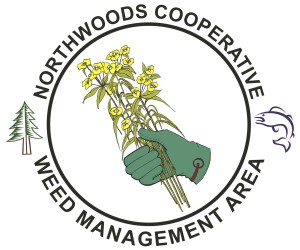Leafy Spurge
Origin & History:
Leafy spurge (Euphorbia esula) is a native plant from Europe and Asia. It was first reported in the United States in Massachusettes in 1887. It is thought to be introduced to the U.S. a number of times as a contaminate in grain seed. It is now thriving in the northern and western parts of the United States as well as the southern parts of Canada, infesting more than 5 million acres.
Why are these plants a problem?
These plants displace native vegetation and are resistant to control efforts because of their high seed production and extensive root network. They can withstand a variety of habitats. Leafy spurge are the most successful in sunny sites with sandy soils.
Leafy spurge are toxic to wildlife, cattle, and other ruminants. They produce a toxic, milky sap that is found throughout the plant structure. Livestock tends to avoid eating the leafy spurge infested areas, but they may unintentionally ingest dry plants mixed in the hay. Due to avoidance of spurge infested areas, overgrazing and disturbance in spurge-free areas reduces the competition of native plants, allowing spurge and other exotic plants to colonize these pasturelands. This results in loss of wildlife because of degrading habitats, reduced species diversity, loss of productive pasturelands, and lower property values. As years go on, the populations of leafy spurge are increasing at an alarming rate leaving more economic and ecological impacts.
How to identify leafy spurge:
- General: A perennial that grows 6 to 36 inches tall. Plants produce a milky sap called latex. Latex is toxic when injested by ruminats and produces dermatitis and blisters in humans.
- Flowers: Small greenish-yellow flower bracts. Flowers from late spring to mid-summer. Mowed stems may flower later.
- Leaves: Pale bluish-green, alternate, long and narrow, and pointed at the tip. No teeth.
- Roots: Extensive. They grow vertically down to 15 feet deep and laterally up to 35 feet..
Habitat:
Leafy spurge is an invader of pasures, roadsides, grasslands, and prairies. It grows in full to part sun in a wide range of soil types, from dry to moist.
Manual/Herbicide Control:
Leafy spurge can be controlled by prescribed fire, mowing, sheep/goat grazing, and herbicides.
Biological Control:
Flea beetles (Aphthona spp.) emerge from the soil in late spring to early summer. Following emergence, adults feed on leafy spurge leaf tissue and mate. Females begin laying eggs in clusters of 3-15 eggs almost immediately. Egg laying continues every three to five days throughout the adult lifestage. Flea beetle females produce an average of 220 to 280 eggs over a lifetime. The longevity of these beetle species varies each year depending on weather conditions. They do not life as long during a hot, dry spring and summer. Beetles prefer cool, wet seasons. Adult beetles has a lifespan of 1.5 to 2 months. Most of these beetles only have a single generation each year.
How the Aphthona spp. does their work:
Flea beetles undergo three larval instars. First-and second-instar larvae feed on filamentous and larger leafy spurge roots. Third-instar larvae feed on root crown. Flea beetles overwinter as second-and third-instar larvae in the soil. Larval feeding begans to decline when soil temperatures fall below 45 degrees fahrenheit and resume feeding in the spring when temperatures warm to above 45 degrees fahrenheit. In early spring, the third-instar larvae will generally feed for some weeks before pupation. Larvae will pupate away from the roots and emerge as adults.
Major damage to leafy spurge occurs when the larvae feed on the roots. They will feed on both the fine feeder roots used by the plant to absorb water and nutrients and the storage tissue of the root crown. This feeding destroys both root tissue directly and causes the plant to be more susceptible to other methods of control; such as chemical control.
Sources:
"Leafy Spurge Biocontrol" from the Noxious and Invasive Weeds Program, Minnesota Department of Agriculture. Available at: https://www.mda.state.mn.us/plants/pestmanagement/weedcontrol/noxiouslist/leafyspurge/leafyspurge
Wisconsin Department of Natural Resources, Invasive Species Factsheets: Available at: https://dnr.wisconsin.gov/topic/Invasives/fact/LeafySpurge
Wisconsin DNR Factsheet. "Management of invasive plants in Wisconsin: Leafy spurge (A3924-30)" Available at: https://cdn.shopify.com/s/files/1/0145/8808/4272/files/A3924-30.pdf


